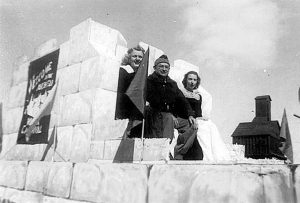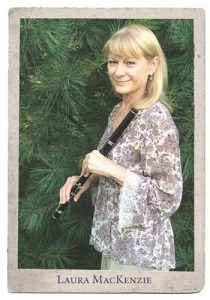
“It’s here!” This note, with a big smiley face drawn on it, was in my mailbox at St. Olaf late in the first term of my freshman year in 1964. The smiley face tipped me off to the sender: Miles (known to everyone as Mity) Johnson, the St. Olaf Band director. The new alto clarinet had arrived, to replace a much older one I had been using up to this time.
Although I was not in the St. Olaf Band all four years, since I left snowy Minnesota in January of my junior year to study Spanish through May at the University of Vera Cruz in Mexico, being a member of this band is still one of the things I value most as I look back on my college experience here in Northfield. I ended up in New York, but I had family who had settled in town and on my visits back, I would go up the hill to visit with Mity, who always remembered me and always eagerly showed me pictures he had on the wall of band members from my era.
“Here’s Renee in New York. She is doing so well, singing professionally there,” he would say proudly, showing a glamorous photo of Irene Gubrud, who had been our piccolo player and soprano soloist on tours. And we would reminisce about the June 1966 band tour to Norway, Denmark and Germany, only the second overseas tour of the St. Olaf Band. Our tour commemorated the 60th anniversary of the July 1906 trip to Norway of the all-male, 46-member St. Olaf Band, under the direction of F. Melius Christiansen (who, of course, gained fame as founder and first director of the St. Olaf Choir). This early band, which had a rousing reception all over Norway due to its skillful performances and the proud Norwegian heritage of St. Olaf, was the first American collegiate musical organization to undertake a concert tour in Europe. The 1906 band introduced Norway to the saxophone (and to baseball).
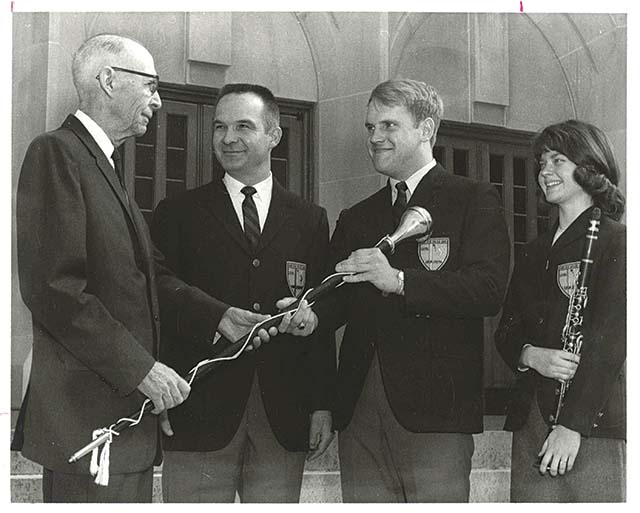
Luckily, we were not expected to show our ability with bat and ball. We were, however, expected to march in some of the cities of our tour, even though we were a concert band. It helped that some of us had been in high school bands that had marched in parades and Mity convinced us that our marching practices on St. Olaf Avenue before the trip would suffice. We even had a majorette in a glittery gold outfit who twirled a baton and was pictured under the headline “Svingende amerikanerinne” (“Swinging American”) in Stavanger, Norway. Our drum major was French horn soloist Ronald Sell, who went on to success playing with the American Symphony and as musical contractor for Broadway shows in New York. Ron is pictured with Mity in the Minneapolis Tribune of May 15, 1966, receiving a drum major’s baton of the 1906 tour from George Mohn, who had been a member of that band (and was the son of St. Olaf’s first president, Thorbjørn Mohn).
The souvenir booklet and a scrapbook I have kept all these years awaken other memories of our grand adventure. It started off with my first plane ride. Yes, really. I wrote my folks that the first leg from Minneapolis to New York on United “changed my whole perspective on the world!” The second leg on Icelandic Airlines was less thrilling. Due to weather conditions, we had an unexpected 1½-hour stopover at the Gander terminal in Newfoundland en route to Luxembourg and Germany. Already sleep-deprived, we were getting squirrelly. Then Mity, attuned as always to the situation, started whistling the “Col. Bogey March” and began to march around the terminal. We all fell into lines behind him, whistling and pretending to play our instruments, which turned the stopover into a fun experience.
After the first performance in the concert hall at Trier, Germany, I wrote home about the wonderful audience there, which “clapped and stomped like mad,” especially when the cornets and trumpets jumped up on the final strain of our encore of (what else?) Sousa’s “Stars and Stripes Forever.” The Trier newspaper wrote, “In spite of having just arrived, the members looked fresh and well reposed and the performance of the Festive Overture [Shostakovich] was therefore impeccable.” Our stay in Germany was highlighted by playing while on a cruise past castles on the Rhine River which was filmed for television broadcast throughout the country. The reviewer in Frankfurt wrote, “…they are not giving the impression of amateurs, but rather professionals,” “an unmistakably first-class and well-disciplined ensemble…The young soprano was quite outstanding.”
As I look back on the list of music we prepared for Europe, I am astounded: 15 concerts works (from Bach to Mozart to Grieg to Schuman to Copland to F. Melius Christiansen’s “Psalm 50,” arranged for band by Mity), 12 marches (from Sousa to Meredith Wilson’s “76 Trombones”), 10 Broadway musicals and American folk music (including classics “Porgy and Bess,” “West Side Story,” “My Fair Lady,” and “Sound of Music”), plus other solo and ensemble works and national songs of the countries. The program was adapted to our musical venues: from parks (Bad Hersfeld and Planten und Blumen in Germany), cathedrals (including Bergen and the remarkable 12th century Nidaros Cathedral in Trondheim where we had a ceremony at the grave of B.J. Muus, founder of St. Olaf College), concert halls and music festivals including Harstad, in the “land of the midnight sun.” We played in a town hall in Odense, Denmark, and even marched and set up to play on a busy downtown Copenhagen street.
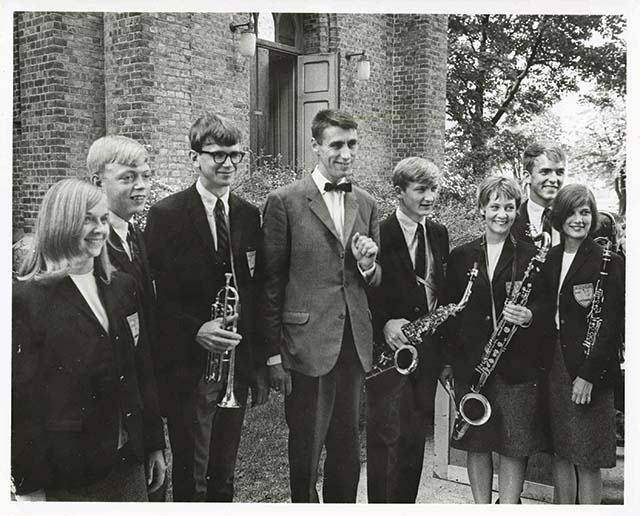
At our first stop in Norway, we were met at the Stavanger railway station by a band playing “Um Ya Ya.” After our performance in a spectacular concert hall, I wrote that our reception was “out of this world,” one of the largest turnouts for a concert that the city of 80,000 had ever seen. All four daily newspapers praised the band and one said, “The conductor, Miles Johnson, who managed the performance in an excellent way and showed himself as a brilliant instructor with a keen sense for everything that produces pure music, graciously turned the resounding applause over to his musicians.” We were rewarded with a boat trip through the magnificent fjords – I wrote I could almost see the trolls hiding along the shore.
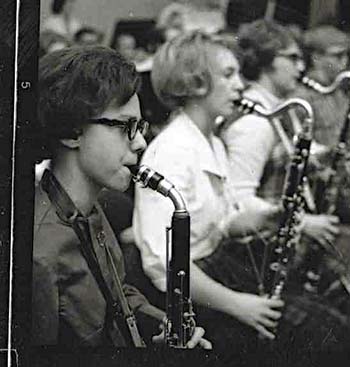
In Oslo, Mity and Ron met with King Olav and we had receptions at the American Embassy and Town Hall. There was a parade downtown and concert in the Aula at the University of Oslo. Norway’s largest paper reported the band “played with catching freshness and a discipline that was worthy of being taken as a model. To director Miles Johnson must go great honor for presenting a band of such high standard.”
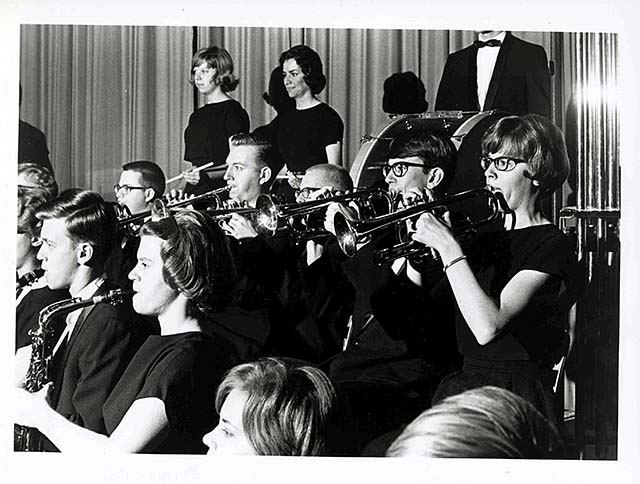
I checked the phone directory in Oslo and was pleasantly surprised to find 19 Hvistendahls listed there. On a day off, I visited Yngvar Hvistendahl in Tønsberg with whom my father had been in contact about Hvistendahl genealogy. Turns out my family is from the Danish branch, but Yngvar (a ship owner who had managed whalers) and his wife happily showed me around town and took me to lunch at their sailing club.
In Fredrikstad, Norway’s noted composer Egil Hovland praised the band’s interpretation of his work “Fanfare and Choral,” which he had composed specifically for this tour, saying, “To have the choral executed in this manner is like being lifted up to heaven.” After the Harstad Music Festival of North Norway, north of the Arctic Circle, a newspaper wrote that Mity, “always smiling and relaxed,” stood in front of the band as a “living stimulus,” succeeding in having us “produce with grandeur.” At the end of the concert, “the public refused to move from their chairs,” caught up in the excitement of the performance.
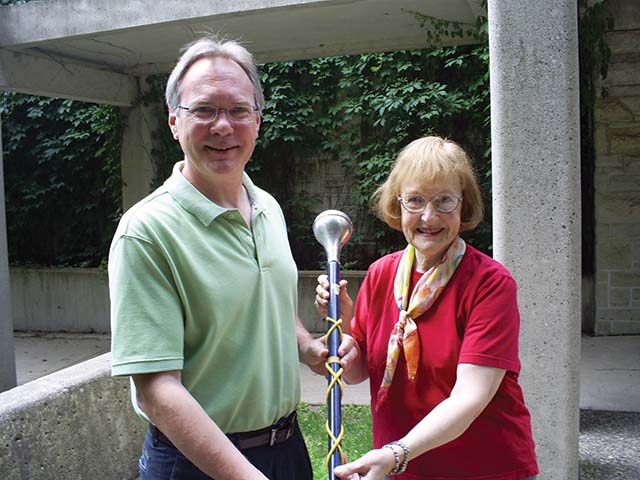
When the trip was over, Mity pronounced the whole experience “miraculous,” with not one bad concert despite the tiring pace. The 27-concert tour of our 77-member band had covered 8,000 miles from May 30-June 27. As Mity often said, “We’re all in this together,” and we carried it off, paving the way for trips abroad which have continued for St. Olaf Band members ever since.
Miles (Mity) Johnson, Heart and Soul of the St. Olaf Band
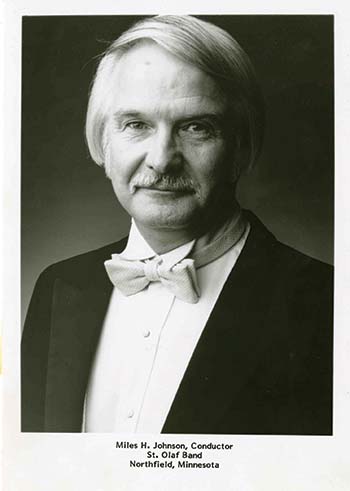
Miles (Mity) Johnson, who conducted the St. Olaf Band from 1957 to 1994, will have served the longest term as conductor in this band’s history unless Timothy Mahr is still directing in the year 2031. Mahr, St. Olaf Class of 1978 (who succeeded Mity) says, “I hope he retains that record!” though Mahr clearly delights in being leader of one of the best collegiate concert bands in the country. F. Melius Christiansen was the first music director to lead the band, starting in 1903, followed by J. Arndt Bergh, Donald Berglund and Bruce Howden, before Mity took over. Here is a timeline of just a few of the highlights of Mity’s life:
1929: Miles (Mity) Johnson is born on Feb. 28 in Elbow Lake, Minn..
1951: Mity graduates from Concordia College, Moorhead, where he meets and marries his wife Myrna. (They go on to have three children, Sarah, Sigurd and Tor.)
1952: He receives a master’s degree in music from Western Reserve University in Ohio.
1957: After 18 months of service in the Korean War and after teaching high school music for three years in Hawley, Minn., Mity begins his 37-year career as band director at St. Olaf. Mity said later that music department chairman Olaf Christiansen (son of F. Melius) allowed him to “create my own program; explore and experiment; and design the course the band should follow.”
1966: Johnson revives overseas band trips in June as he leads the St. Olaf Band to Germany, Norway and Denmark to commemorate the 1906 St. Olaf Band tour of Norway. (See accompanying story.)
1972: On May 25 the St. Olaf Band joins the Chapel Choir and Modern Dance Group on Capitol Hill to perform a work written by St. Olaf senior Kurt Westerberg commemorating the 1970 shootings of students at Kent State. (Mity, a Korean war vet, takes part to lend support to the students who are venting their frustration about the war in Viet Nam.)
1973: Mity is named one of Ten Outstanding Music Educators in the United States. Well-known as a French horn recitalist and brass specialist, Mity presides over many clinics, camps and all-state bands and festivals over the years.
1974: A Cathedral Concert series is inaugurated when the St. Olaf Band performs at the WW II ruins of the 1918 Coventry Church in England in honor of the 100th anniversary of the founding of St. Olaf College. (The final concert of the series is held at Wooddale Church in Eden Prairie on March 20, 1994, Mity’s last year at St. Olaf.)
1978: Mity establishes the original Minnesota Symposium on Instrumental Conducting.
1979: Mity forms the Minnesota Symphonic Winds adult community band with alumni and others in the Twin Cities area. This group continues today under the direction of Timothy Mahr.
1987: Mity’s 30th anniversary year includes a royal performance in Oslo. He is named Music Educator of the Year by the Minnesota Music Educators Association and a day in his honor is proclaimed in the state of Minnesota by Gov. Rudy Perpich.
1991: On the 100th anniversary of the founding of the St. Olaf Cornet Band, Mity leads a three-week trip to the British Isles.
1993: The Miles Johnson Endowment Fund is established. (Myrna Johnson says that the recipients of scholarships write her each year, telling of their heart-felt gratitude about belonging to the band.)
1994: In April, there is a gala concert honoring Mity’s retirement in Minneapolis, featuring the St. Olaf Band, Choir and Orchestra, together for the first time at Orchestra Hall. A highlight is when all three groups join to perform selections from Carl Orff’s “Carmina Burana.” In May, Mity directs the band for the last time at commencement. It is estimated that 4,000 student musicians played under his direction during his 37 years at the helm of the band.
Mity is succeeded by acclaimed composer and director Timothy Mahr (Class of ’78) who had played in the band under Mity and continues Mity’s legacy of excellence in music and warm-hearted relationships with the band members. Myrna says that Mahr keeps the band traditions and “makes sure the kids all know who Mity was.” Mahr replies, “This is absolutely vital. His spirit is alive when the St. Olaf Band makes music. I’ve been the caretaker of the sound that he developed and we are still moving along the path I experienced as a member of the band. We are moving forward with the vision he had for what the band could be.”
2004: After a six-year struggle with Alzheimer’s, Mity passes away on Aug. 26 at the age of 75. As he dies, a record of the St. Olaf Band playing “Elsa’s Procession to the Cathedral” from Wagner’s opera “Lohengrin” reaches its climax, with Myrna and daughter Sarah holding his hand. The services at Boe Memorial Chapel include the family favorite “Movement Nimrod” from “Enigma Variations” by Sir Edward Elgar, directed by Mity’s successor Timothy Mahr. Earlier in May, a St. Olaf Band concert had included an alumni band, 450 in all, honoring Mity, who was unable to attend. But his wife Myrna called it a “love-fest,” showing how many people had been touched by Mity.
I asked Myrna (who is known to many for her long association with the Northfield Arts Guild in Northfield) to write a few words to conclude this column. This was her response:
“Susan: One of the best things that happened to me was the St. Olaf Band! Mity was the reason, but all the love of those band members thru the years was (and is) a blessing I can never measure! We all had a great time – I was on every band tour that ‘they’ all went on (thanks to my parents and friends who helped with the family) – so I experienced the special times of concerts, set up, fun on the bus etc., etc. I didn’t just ‘hear’ about it – I was there!!
“Mity was not only an inspiration in all ways but so energetic and alive – he lived and breathed the St. Olaf Band. I always have said he was exciting to ‘fall in love with’ and exciting and a privilege to know and spend over 50 years with…”
Mity and Myrna had always opened their home to band members and considered them to be part of their family. Myrna noted that many of the “kids” from the 1966 European tour that I had gone on with the band still are her friends today and provide inspiration to her. She ended: “As I often say–how lucky can a person be!”
I can only add that all of the band members from 1957 to 1994 who were fortunate enough to have known Mity and Myrna are equally lucky.
My thanks to Myrna Johnson, Timothy Mahr and Jeff Sauve of the St. Olaf Archives. A two-CD set of recordings of the St. Olaf Band in concert from 1957 to 1994 is available at the St. Olaf Bookstore as “The Legacy of Miles H. Johnson” in the Band Masterworks Series.


